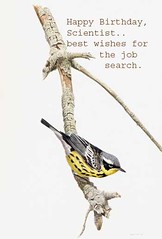The Gift of Birds
 A first-time blog reader emailed a birdthday ecard that he designed just for me! (As you can see from this ecard, which is a detail from a larger painting of his, he is a very talented artist!) I just had to share this with you all because the thought AND the card are beautiful! (If you click on the card, a larger version will show up in its own window).
A first-time blog reader emailed a birdthday ecard that he designed just for me! (As you can see from this ecard, which is a detail from a larger painting of his, he is a very talented artist!) I just had to share this with you all because the thought AND the card are beautiful! (If you click on the card, a larger version will show up in its own window).
The bird pictured here on this card is a male magnolia warbler, Dendroica magnolia (Wilson), a lovely little migratory songbird that breeds in the higher latitudes of North America, mainly in Canada (Fig. 1, below). This bird was named for the magnolia tree, where it was first collected. This sedate warbler can be seen in small trees and shrubs in moist mixed forests and in new-growth. Their favored forest habitats are dominated by aspen trees but also include a variety of conifers, particularly spruce, firs, hemlocks, or pines. These birds' preferred habitat is typically located near water. Magnolia warblers are "neotropical migrants"; wintering in southern Mexico through parts of Central America to Panama. They are seen in Central Park during spring and autumn migration.

FIGURE 1: Breeding range of magnolia warbler (1).
The magnolia warbler is 10.8-12.7 centimeters (approximately 5 inches) from beak to tail. The male (pictured on the card at the top) is intensely colored with contrasting splotches of yellow, black, bluish-grey, white and some olive-green while females and immature birds retain the basic color pattern, but their colors are muted somewhat. Although they do consume some fruits and berries, magnolia warblers are almost exclusively insectivorous; they hunt insects by meticulously collecting them from the undersides of tree leaves and crevices in tree bark. They are monogamous and build a lovely little nest from fine twigs and stems and line the cup with fine grasses or rootlets. This nest is usually built 1-2 meters (4-7 feet) from the ground, saddling the branch of a small conifer and concealed by a well-placed bough immediately above. The birds begin nesting activities in early June and each clutch consists of 4 (3-5) eggs. Their eggs are creamy white with artistically placed cinnamon-colored blotches of varying intensities. The chicks hatch after 11- 13 days of incubation by the female and both parents care for the young. The chicks are helpless when they hatch but grow quickly, leaving their nest 8-10 days after hatching. Both parents care for the young fledglings for as long as 25 days after they fledge.
Their song is often described as "wheeta wheeta" followed by a descending "wheetsee" (2) or "wisha-wisha-wisha" with the accent on the first syllable.
===============
(1) Magnolia warbler breeding range map is linked from the Patuxent Wildlife Research Center without permission and with no intention to profit in any way whatsoever, except to provide my readers with interesting information about this species. This map was compiled using Breeding Bird Survey (BBS) data collected by thousands of volunteer birders throughout the years. [Gough, G. A., Sauer, J. R., Iliff, M. Patuxent Bird Identification Infocenter. 1998. Version 97.1. Patuxent Wildlife Research Center, Laurel, MD.]
(2) Magnolia warbler song is linked from the Patuxent Wildlife Research Center without permission and with no intention to profit in any way whatsoever, except to share my joy of birds and their song with my readers. The song file is and remains the sole property of the recordist, John Sauer. [John R. Sauer, Patuxent Bird Identification Infocenter. 1998. Version 97.1. Patuxent Wildlife Research Center, Laurel, MD.]
© 2004, 2005, 2006 by GrrlScientist











4 Peer Reviews:
Pardon me, Hedwig, but where am I supposed to see the e-card?
Bye and keep wrinting, please. I really enjoy reading you.
Marco
Ok. Now I see it. And it's wonderful, you're right. But (s)he must be a professional.
Marco
It's good to hear from you again, Marco! Thanks for your kind words about my writing. And yes, as you suspected, this person is a professional artist who is overwhelmed with work at the moment. He asked me not to link to his website just yet because he wants to take a small vacation before all the people who read my blog decide to commission him to do more bird paintings.
PoetryHi there, just thought I'd say hello...
I've been looking at sites with Poetry , and came across some great suggestions... and although your's wasn't an exact match - it did catch my eye...
There seems to be loads of sites offering Poetry these days- Hopefully I'll find plenty of inspiration.
If you'd care to have a look at my site it's at http://free-poems-and-poetry.com and all free to use..
Happy holidays
Poetry
Post a Comment
<< Home